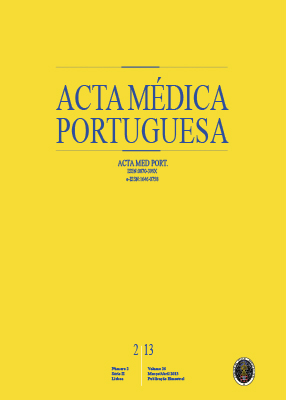Atrial Fibrillation in Cerebrovascular Disease: National Neurological Perspective
DOI:
https://doi.org/10.20344/amp.85Abstract
Background: Cardioembolism due to atrial fibrillation assumes a dominant etiologic role in cerebrovascular diseases due to its growing incidence, high embolic risk and particular aspects of clinical events caused. Our objectives are to analyze the frequency of atrial fibrillation in patients with ischemic stroke, study the vital and functional impact of stroke due to different etiologies and evaluate antithrombotic options before and after stroke. Methods: We conducted a retrospective study including patients admitted in a central hospital due to ischemic stroke in 2010 (at least one year of follow-up). Etiology of stroke was defined using the Trial of ORG 10172 in Acute Stroke (TOAST) classification, and functional outcome by modified Rankin scale. We performed a descriptive analysis of different stroke etiologies and antithrombotic medication in patients with atrial fibrillation. We then conducted a cohort study to evaluate the clinical impact of antithrombotic options in secondary prevention after cardioembolic stroke. Results: In our population (n = 631) we found superior frequency of cardioembolism (34.5%) to that reported in the literature. Mortality, morbidity and antithrombotic options are similar to other previous series, confirming the severity of cardioembolic strokes and the underuse of vitamin K antagonists. Oral anticoagulation was effective in secondary prevention independently from post-stroke functional condition. Conclusions: Despite unequivocal recommendations, oral anticoagulation is still underused in stroke prevention. This study confirms the clinical efficacy of vitamin K antagonists in secondary prevention independently from residual functional impairment.
Downloads
Downloads
Published
How to Cite
Issue
Section
License
All the articles published in the AMP are open access and comply with the requirements of funding agencies or academic institutions. The AMP is governed by the terms of the Creative Commons ‘Attribution – Non-Commercial Use - (CC-BY-NC)’ license, regarding the use by third parties.
It is the author’s responsibility to obtain approval for the reproduction of figures, tables, etc. from other publications.
Upon acceptance of an article for publication, the authors will be asked to complete the ICMJE “Copyright Liability and Copyright Sharing Statement “(http://www.actamedicaportuguesa.com/info/AMP-NormasPublicacao.pdf) and the “Declaration of Potential Conflicts of Interest” (http:// www.icmje.org/conflicts-of-interest). An e-mail will be sent to the corresponding author to acknowledge receipt of the manuscript.
After publication, the authors are authorised to make their articles available in repositories of their institutions of origin, as long as they always mention where they were published and according to the Creative Commons license.









